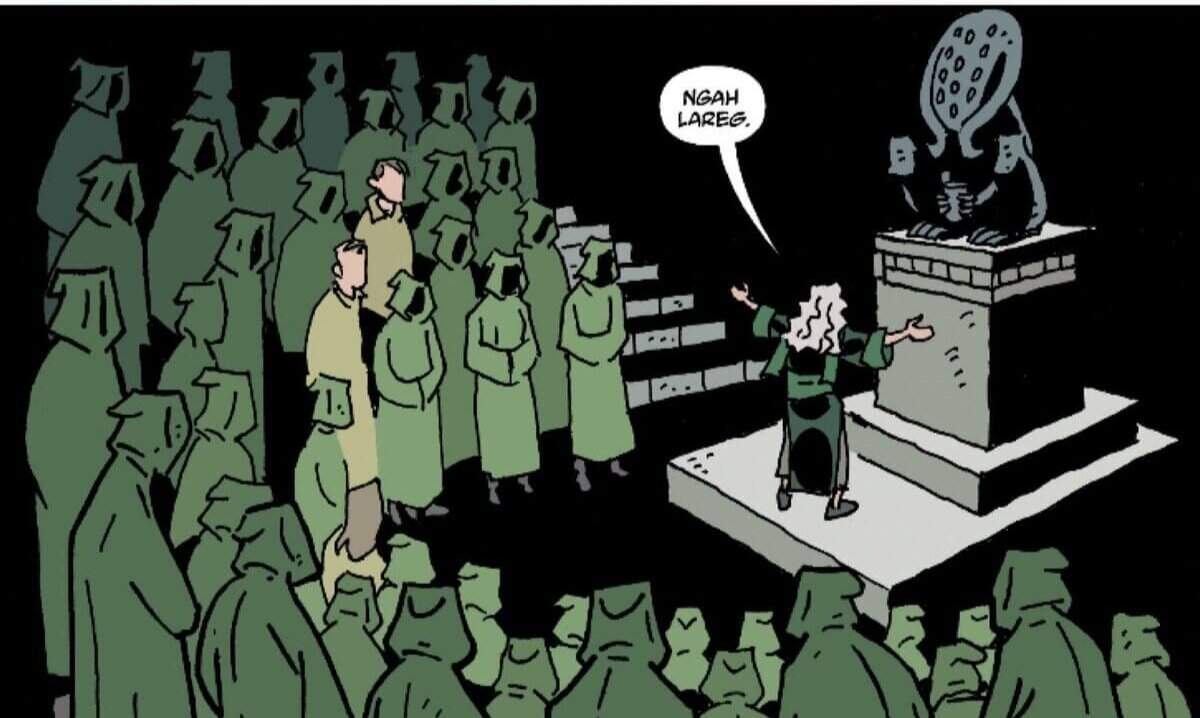Writers: Mike Mignola, Chris Roberson, John Arcudi / Pencillers: Christopher Mitten, Jason Latour, Laurence Campbell, Paul Grist / Colour Artists: Dave Stewart, Bill Crabtree / Letterer: Clem Robbins / Collects: Rasputin: Voice of The Dragon #1-#5, Sledgehammer '44 #1-#2 Sledgehammer '44: The Lightning War #1-#3 The Visitor: How And Why He Stayed #1-#5 / Dark Horse Comics
Buy Hellboy comics here and support The Comic Crush.
6th June 2021
The Pitch: When did Rasputin find his calling to bring about Ragna Rok? How did the Visitor stay hidden on Earth for so long? And where did the legendary Sledgehammer armour really come from? These questions and more are answered in this new collection from the world of Hellboy! Three stories of instrumental side characters are explored in full, collected for the first time in a handsome hardcover perfect for any Hellboy fan's library. Hellboy creator Mike Mignola is joined by John Arcudi, Chris Roberson, Laurence Campbell, Christopher Mitten, Dave Stewart, and others to bring these hidden corners of the Mignolaverse to light.
One of the great pleasures of Mike Mignola's extended Hellboy Universe – beyond the consistent quality of its art and writing – is just how interconnected it all is. For those of you that think the story began with the arrival of Hellboy in World War II, here is a collection of three, five-issue mini-series that shows the chess pieces being moved into place before that event. And also reveals what happened on the sidelines to ensure Hellboy's victories. Not only that, but we see how rich the near limitless sea of characters that make up this universe are and that they're ripe for stories and arcs of their own.
THROUGH WRITING, ART AND LETTERING, YOU HEAR RASPUTIN’S SONOROUS INCANTATIONS
The book displays Mignola's gift for taking disparate story threads and weaving them together. Beginning with Hellboy's true nemesis, Rasputin himself. Found alive by the Nazis in 1937, we learn of the Master's earliest visions of Ragnarok. His pathological need to bring about the return of the Ogdru Jahad, spurred on by the Voice of the Dragon. This is a story of resurrection, both of physical forms and of vengeful spirits. The story manages to showcase the deeper Lovecraftian underpinnings of the Hellboy universe as well as satisfying the audience's love of pulpy monster-mash. Mignola and Roberson also give us a rip-roaring international WWII espionage adventure with young Professor Bruttenholm crossing ancient boundaries in England, dealing with the Helioptic Brotherhood of Ra in France and teaming up with the supernaturally gifted spy Saudhu to battle Rasputin and Kroenen.
Christopher Mitten's art in this story has a documentary feel, His urgent style amps up the excitement and terror. His faces feel like they belong in a British wartime propaganda picture, made by Powell & Pressburger's Archers production company. That is to say, it feels exactly as it should. Clem Robbins' letters capture the fear in Bruttenholm's voice as he realises his future is no longer desk-bound, but in the field. Through the art and the letters, you also feel the sonorous timbre of Rasputin's incantation as he seduces the Reich. Dave Stewart, surely one of the greatest colourists in comics history perfectly creates the soft glow of lights in wartime buildings, the harsh light of headlamps of Nazi trucks and the awesome luminosity of ceremonial fire.
CAMPBELL’S VISUALS ADD A DANGEROUSLY GORGEOUS TONE TO PROCEEDINGS
The action and visuals shift in the two Sledgehammer '44 stories. This moves even further into the 'behind enemy lines' story-telling before a gear-shIft brings us a movingly spiritual sequence of a soldier clinging to his final moments and thinking of his comrades. It's always surprising just how much heart the storytellers manage to craft into the Hellboy books. There is genuine pathos in this story. Mignola and Arcudi craft an excellent book, working well as longtime collaborators should. Jason Latour creates a world of fire, a true war-is-hell piece that still embraces the absurdity of a man in a giant metal suit. The real stand-out in the second story, The Lightning War, is Laurence Campbell making his Hellboy universe debut. His dark and furious visuals add a dangerously gorgeous tone to proceedings. It's the same beauty you see looking at burnt embers. And honestly, there is a beauty to that! Again, Dave Stewart and Clem Robbins add the finishing magic creating a grim feel to the books.
crabtree’s colours use grist’s minimalist style perfectly
Mignola reteams with Roberson for the Visitor: How and Why He Stayed. The pace changes entirely. We arrive back at that critical moment when Hellboy is summoned to Earth by Rasputin's magic. Observed by a member of an alien race who holds Hellboy's fate in their hands, this becomes a tour through critical moments in Big Red's growth. This is a story of tolerance. You come to realise that it's not just the Visitor's body that stays on Earth, but his hand that stays from killing Hellboy as a child, having gigantic repercussions for the world entire. As we watch a replay of moments and memories, there is another character whose memories fade and re-order, breaking the visitor's heart as they do. To reveal more would spoil some surprises in the story, so I'll talk about the craft here instead. Paul Grist creates a wonderfully open style, full of the wonderful weirdness we know and love from his previous work. Robins returns as letterer marking out a nice style that changes as the story moves through different periods. Bill Crabtree's colours use Grist’s minimalist style wonderfully, making the characters stark against backgrounds, casting our minds back to the earliest, thrilling Hellboy stories. In total, what's here is a beginning to events already writ, but surprising all the same... A Secret History.
Buy Hellboy comics here and support The Comic Crush. Hellboy Universe: The Secret Histories is available now at your favourite comic book shop.




